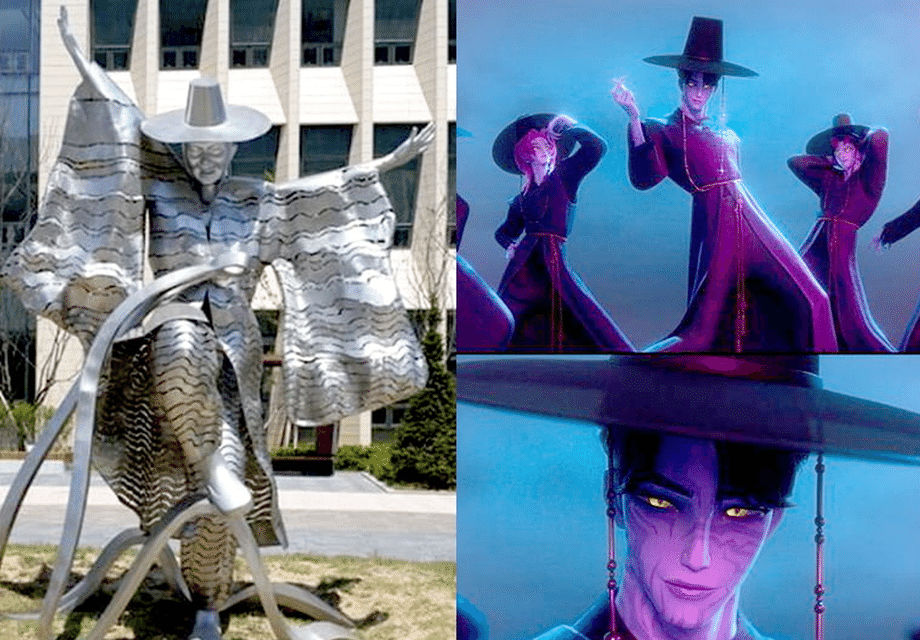Why a Sejong statue is back in the spotlight
A metal sculpture in Sejong, South Korea, that was removed after residents said it looked like a grim reaper could soon return to public view. The figure, which depicts a man in traditional dress mid dance with arms spread wide, has reentered national conversation after Netflix’s animated hit KPop Demon Hunters put Korean afterlife imagery in front of a new global audience. Government officials say they are reviewing petitions to reinstall the work, and if approval comes, the new location would be set through procedures under the Culture and Arts Promotion Act.
- Why a Sejong statue is back in the spotlight
- What the artwork shows and how it was commissioned
- From dancer to grim reaper in the public eye
- KPop Demon Hunters gives the statue new life
- How reinstallation would work under Korean law
- Why the figure reads as a grim reaper to some viewers
- Public art controversies and what communities can do
- The money question and stewardship duties
- What happens next
- Key Points
The artwork is best known by translations such as Joyful Korean Melody, Our Merry Tune, or Joyful Korean Rhythm. It was one of several pieces installed a decade ago at Government Complex Sejong, near the National Tax Service building. Residents and some public officials complained that the smiling face, the dark metallic finish, and night lighting made the figure unsettling. The piece was moved and later taken down. Interest has surged again as viewers connect the sculpture’s look to the Saja Boys in KPop Demon Hunters, which imagines a demon hunting idol group drawn from the Korean tradition of jeoseung saja (grim reapers in folklore).
What the artwork shows and how it was commissioned
The figure portrays a dancer in traditional attire, including a gat, the wide brimmed horsehair hat most associated with the Joseon era. The pose captures a moment from hallyangmu, a classic dance style. Arms extend outward like a takeoff gesture, and the face carries a fixed smile. The surface is cold metal, a choice that reads as sleek during the day and stark in poor weather. The intent, according to descriptions cited by local outlets, was to present grace, dignity, and an accessible snapshot of Korean performance culture.
The sculpture was part of a public arts initiative that placed six works at the government complex. Reports vary on the exact figures, but the overall project budget was about 1.1 billion won, with the statue’s value cited between roughly 105 million and 150 million won in different articles. It stood in front of the National Tax Service building when first installed, and later was briefly relocated nearby. The piece’s different English names reflect translation choices for the Korean title (often rendered as Urigarak, meaning our melody or our tune), a common situation for public art commissioned for domestic audiences and later covered by international media.
From dancer to grim reaper in the public eye
Shortly after installation, complaints began to accumulate. Residents said the combination of the gat, the rigid smile, the elongated arms, and the metallic sheen evoked an otherworldly figure. Many compared it to a grim reaper or a shamanic guardian. Complaints intensified at night when floodlights created sharp shadows on the face and hands. On rainy days, the glossy surface reflected streetlights in a way that some passersby found unnerving. Critics also questioned public spending, arguing that a piece that unsettled so many should not sit at the entrance to a major government building.
Officials responded by moving the work about 100 meters from the original site, then later dismantling it. There is inconsistency among news outlets about the exact timeline, with dates ranging from 2016 to 2019 for the removal. Several reports agree that the statue was stored in an underground parking area at the complex. The controversy became a local cautionary tale about how placement, materials, and lighting can transform public perception of a work’s intent.
KPop Demon Hunters gives the statue new life
The Netflix film KPop Demon Hunters has pushed Korea’s grim reaper imagery into mainstream conversation worldwide. The story features the Saja Boys, an idol group with motifs drawn from jeoseung saja, spirit guides familiar from folklore, literature, and screen. As the film gained traction, social media users in Korea began posting side by side images that compared the Sejong dancer’s silhouette and facial expression to the Saja Boys’ stylized look. Posts called the Sejong work the grim reaper statue and urged authorities to take it out of storage.
Those online reactions spilled over into formal requests. The Government Complex Management Office confirmed it is reviewing petitions asking for reinstallation. The Ministry of the Interior and Safety also acknowledged the review process. Several outlets reported that officials are open to the idea if it clears required deliberations under the Culture and Arts Promotion Act. That law governs significant decisions about public artworks, including installation and relocation, and it gives authorities a structured way to balance artistic merit, public interest, and site suitability.
Officials caution that any decision must hold up over time. A representative of the Government Complex Management Office, quoted by local media, framed the challenge this way before acknowledging the petitions and the pop culture surge. The representative said the government cannot chase every shift in taste.
Introducing the official’s comments, multiple reports quoted the Government Complex Management Office on the limits of trend driven decisions. The official said:
We cannot simply reinstall and remove a statue based on shifting public sentiment.
The Interior Ministry’s stance, reported by the JoongAng Daily, leaves the door ajar while stressing due process. It said the idea was not off the table once reviews conclude.
The ministry said reinstallation is not impossible, provided it passes the necessary review under the Culture and Arts Promotion Act.
How reinstallation would work under Korean law
Public art at national sites involves several layers of review. In cases like this one, the relevant management office and the Ministry of the Interior and Safety weigh petitions, legal requirements, and site conditions. The Culture and Arts Promotion Act provides the framework. Reviews can consider whether the original artwork remains intact, whether restoration is needed, the effect of materials in the chosen setting, and how signage or lighting could support public understanding. Committees can also consider whether a new location better suits the work’s scale and tone.
If reinstalled, the piece would likely receive more contextual signage than in its first life, including an explanation of hallyangmu, the role of the gat in historical dress, and the artist’s statement of purpose. Lighting is often reconsidered after a controversy, because the same lamp angles that make sculpture surfaces gleam at dusk can cast faces in exaggerated shadow. A more forgiving light plan could soften the statue’s nighttime presence, which was one of the core triggers of the initial backlash. Authorities may also stage a public walk through before final placement to test sightlines and reactions.
Why the figure reads as a grim reaper to some viewers
Jeoseung saja are familiar figures in Korean folklore and popular culture. The term refers to beings who guide the dead to the afterlife. They are often portrayed in dark clothing, sometimes with a gat. That profile, along with a calm or slightly eerie facial expression, has appeared in films, dramas, webtoons, and games. When people saw the Sejong statue’s traditional hat, elongated sleeves, stiff grin, and metallic finish, many mapped those features to the saja archetype already in mind from entertainment and folklore.
This reaction shows how visual context shapes meaning. Public art does not come with a curator’s wall text or a darkened theater to set tone. A cold metal finish in rain or fog can amplify associations that are not present in daylight. A dance pose can look graceful in motion, then unsettling in a still image when arms are extended and a smile does not move. The Sejong figure was designed to celebrate dance values that many people admire, especially poise and control. A fixed smile and forward posture that communicate elegance on a stage can read as ominous when frozen, up lit, and framed by government stonework.
The arrival of KPop Demon Hunters has flipped that meaning for a different audience. The film’s stylized Saja Boys have made jeoseung saja imagery feel current and cool to many viewers. That shift may have softened the eerie edge the statue carried a decade ago. The same hat and gesture that once read as otherworldly now sit in a pop context, where symbols are playful, kinetic, and quickly remixed across memes and fan edits. People are asking to see the sculpture again with fresh eyes, and this time they might read the facial expression as charismatic rather than chilling.
Public art controversies and what communities can do
Arguments over public sculpture are common in many countries. Complaints often arise from three issues that are present in Sejong’s case. First, people do not share a creator’s reference points, so intent gets lost without context. Second, daytime and nighttime views can diverge, especially with metal surfaces and dramatic lighting. Third, placement near a civic building increases expectations that the work should feel welcoming as well as thought provoking.
When governments revisit controversial pieces, they often use several tools. Public walkabouts and workshops can gather feedback before final placement. Clear signage that explains the dance, costume, and artistic goal can prevent misreadings. Lighting and landscaping can guide the eye and soften stark edges at night. Rotating works through a sculpture park or cultural campus can reduce the pressure that any single piece must function as a doorway to the state. Some cities also pair contentious works with programming, for example outdoor dance demonstrations that show the movement the piece tries to capture.
These practices do not silence critics, and they should not. They give more people a chance to understand what they are looking at and why a public agency made a given choice. In Sejong’s case, if the statue returns, its new context will be judged as closely as the work itself. The measure of success will be whether daily passersby feel the site matches the sculpture’s energy and whether night lighting respects the piece’s contours rather than exaggerating them.
The money question and stewardship duties
Public spending sits at the heart of this debate. Reports put the overall six sculpture program at about 1.1 billion won. Individual estimates for the dancer range from around 105 million to 150 million won, reflecting different project accounting in press coverage. Critics argued that even a modest outlay was wasteful if the piece frightened people walking to their offices. Others countered that commissioning local art is a basic cultural duty for a national complex and that taste swings are part of the risk that comes with any public program.
Reinstallation would carry costs, though not on the scale of a new commission. Storage, restoration if needed, transport, mounting, and new lighting or signage would draw on maintenance budgets. A transparent process can help taxpayers see line items and understand what is being spent and why. Officials quoted in multiple outlets have already signaled a cautious approach, which suggests they are weighing both cultural benefits and stewardship obligations. If the piece returns to a site designed to fit its tone, supporters will argue the initial investment finally yields the public engagement the project sought a decade ago.
What happens next
For now, the sculpture remains in storage while officials monitor petitions and public sentiment linked to KPop Demon Hunters. The Government Complex Management Office and the Interior Ministry have said a decision will follow reviews required by the Culture and Arts Promotion Act. If approvals come, the next steps would include selecting a site, considering lighting and signage, preparing a transport and installation plan, and announcing a timetable. Some reports suggest a location change is likely to move the work away from the main entrance to a setting where viewers can approach it from several angles, which can change how the facial expression and pose are read.
Reinstallation would also be a chance to use the moment as a cultural lesson. A short explanation could introduce jeoseung saja and why that imagery sits so close to traditional costume in the public mind. Another panel could describe hallyangmu and what physical qualities the artist set out to honor. Clear context does not tell people what to feel. It shows the references the sculpture draws upon. In a media environment where pop culture can alter how symbols are read almost overnight, that context can keep a public work from bouncing between condemnation and trend driven celebration.
Key Points
- Sejong’s dancer statue, long dubbed the grim reaper by locals, is under review for reinstallation after Netflix’s KPop Demon Hunters renewed interest in Korean afterlife imagery.
- The work, known by English titles such as Joyful Korean Melody and Our Merry Tune, was part of a six sculpture program valued around 1.1 billion won.
- Residents said the figure’s smile, gat hat, and metallic finish looked eerie, especially at night, prompting relocation and removal; reports differ on whether that occurred in 2016 or 2019.
- Officials say petitions are being reviewed under the Culture and Arts Promotion Act, and reinstallation is possible if it passes required deliberations.
- The Government Complex Management Office cautioned against trend driven decisions, saying the statue cannot be moved back and forth with shifting sentiment.
- Public discussion now weighs context measures such as improved lighting, explanatory signage, and a new site to better match the work’s tone.
- If restored, the sculpture would likely leave storage for a location chosen through a formal process, with costs limited to transport, restoration, and site upgrades.




